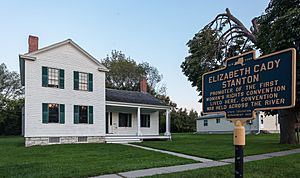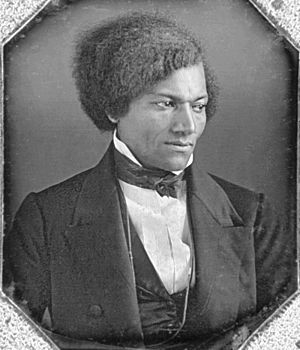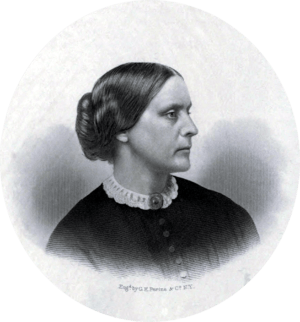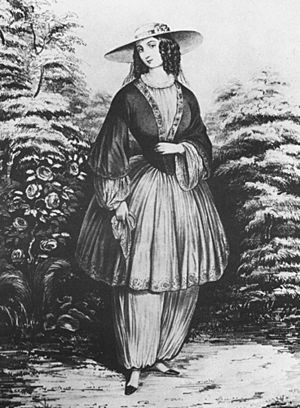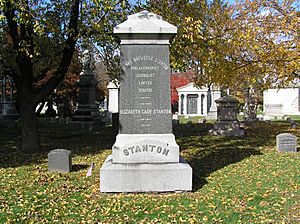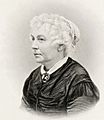Elizabeth Cady Stanton facts for kids
Quick facts for kids
Elizabeth Cady Stanton
|
|
|---|---|
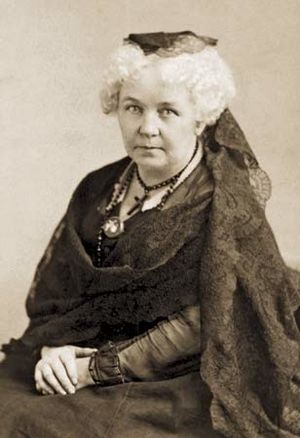
Stanton, c. 1880, age 65
|
|
| Born |
Elizabeth Cady
November 12, 1815 Johnstown, New York, U.S.
|
| Died | October 26, 1902 (aged 86) New York City, U.S.
|
| Resting place | Woodlawn Cemetery, New York City, U.S. |
| Occupation |
|
| Spouse(s) | |
| Children | 7, including Theodore and Harriot |
| Parent(s) | Daniel Cady Margaret Livingston |
| Relatives | James Livingston (grandfather) Gerrit Smith (cousin) Elizabeth Smith Miller (cousin) Nora Stanton Barney (granddaughter) |
| Signature | |
Elizabeth Cady Stanton (née Cady; November 12, 1815 – October 26, 1902) was an American writer and activist who was a leader of the women's rights movement in the U.S. during the mid- to late-19th century. She was the main force behind the 1848 Seneca Falls Convention, the first convention to be called for the sole purpose of discussing women's rights, and was the primary author of its Declaration of Sentiments. She was also active in other social reform activities, especially abolitionism.
Contents
Family background
Elizabeth Cady was born into the leading family of Johnstown, New York. Their family lived in a mansion on the town's main square and had twelve servants. Her conservative father, Daniel Cady, was one of the richest landowners in the state. A member of the Federalist Party, he was an attorney who served one term in the U.S. Congress and became a justice in the New York Supreme Court.
Her mother, Margaret Cady (née Livingston), was more progressive, supporting the radical Garrisonian wing of the abolitionist movement and signing a petition for women's suffrage in 1867.
Elizabeth was the seventh of eleven children, six of whom died before reaching full adulthood, including all of the boys. She was made sharply aware of society's low expectations for women when Eleazar, her last surviving brother, died at the age of 20 just after graduating from Union College in Schenectady, New York. Her father and mother were incapacitated by grief. The ten-year-old Stanton tried to comfort her father, saying she would try to be all her brother had been. Her father said, "Oh my daughter, I wish you were a boy!"
Her mother, exhausted by giving birth to so many children and the anguish of seeing so many of them die, became withdrawn and depressed. Tryphena, the oldest daughter, together with her husband Edward Bayard, assumed much of the responsibility for raising the younger children.
Education
Stanton received a better education than most women of her era. She attended Johnstown Academy in her hometown until the age of 15. The only girl in its advanced classes in mathematics and languages, she won second prize in the school's Greek competition and became a skilled debater. She enjoyed her years at the school and said she did not encounter any barriers there due to her gender.
Stanton had many educational opportunities as a young child. Their neighbor, Reverend Simon Hosack, taught her Greek and mathematics. Edward Bayard, her brother-in-law and Eleazar's former classmate at Union College, taught her philosophy and horsemanship. Her father brought her law books to study so she could participate in debates with his law clerks at the dinner table.
She wanted to go to college, but no colleges at that time accepted female students. Moreover, her father initially decided she did not need further education. He eventually agreed to enroll her in the Troy Female Seminary in Troy, New York, which was founded and run by Emma Willard.
Marriage and family
As a young woman, Stanton traveled often to the home of her cousin, Gerrit Smith, who also lived in upstate New York. At Smith's home, where she spent summers and was considered "part of the family," she met Henry Brewster Stanton, a prominent abolitionist agent. Despite her father's reservations, the couple married in 1840, omitting the word "obey" from the marriage ceremony.
Stanton took her husband's surname as part of her own, signing herself Elizabeth Cady Stanton or E. Cady Stanton, but not Mrs. Henry B. Stanton.
Soon after returning from their European honeymoon, the Stantons moved into the Cady household in Johnstown. Henry Stanton studied law under his father-in-law until 1843, when the Stantons moved to Boston (Chelsea), Massachusetts, where Henry joined a law firm. While living in Boston, Elizabeth enjoyed the social, political, and intellectual stimulation that came with a constant round of abolitionist gatherings. Here, she was influenced by such people as Frederick Douglass, William Lloyd Garrison and Ralph Waldo Emerson. In 1847, the Stantons moved to Seneca Falls, New York, in the Finger Lakes region. Their house, which is now a part of the Women's Rights National Historical Park, was purchased for them by Elizabeth's father.
The couple had seven children. Stanton encouraged both her sons and daughters to pursue a broad range of interests, activities, and learning. She enjoyed motherhood and running a large household, but she found herself unsatisfied and even depressed by the lack of intellectual companionship and stimulation in Seneca Falls.
Due to Henry's work, the couple very often lived apart, maintaining separate households for several years. Their marriage, which lasted 47 years, ended with Henry Stanton's death in 1887.
Personality
Stanton was remembered by her daughter Margaret as being "cheerful, sunny and indulgent."
Activism
Seneca Falls Convention
Both Henry and Elizabeth were staunch abolitionists, but Henry, like Elizabeth's father, disagreed with the idea of female suffrage.
While on their honeymoon in England in 1840, the Stantons attended the World Anti-Slavery Convention in London. Elizabeth was appalled by the convention's male delegates, who voted to prevent women from participating even if they had been appointed as delegates of their respective abolitionist societies. The men required the women to sit in a separate section, hidden by curtains from the convention's proceedings.
Lucretia Mott, a Quaker minister, abolitionist and women's rights advocate, was one of the women who had been sent as a delegate. Although Mott was much older than Stanton, they quickly bonded in an enduring friendship, with Stanton eagerly learning from the more experienced activist.
In the summer of 1848, Lucretia Mott traveled from Pennsylvania to attend a Quaker meeting near the Stanton's home. Stanton was invited to visit with Mott and three other progressive Quaker women. The women agreed to organize a women's rights convention in Seneca Falls a few days later, while Mott was still in the area.
Stanton was the primary author of the convention's Declaration of Rights and Sentiments, which was modeled on the U.S. Declaration of Independence. Its list of grievances included the wrongful denial of women's right to vote, signaling Stanton's intent to generate a discussion of women's suffrage at the convention.
An estimated 300 women and men attended the two-day Seneca Falls Convention. In her first address to a large audience, Stanton explained the purpose of the gathering and the importance of women's rights. Following a speech by Mott, Stanton read the Declaration of Sentiments, which the attendees were invited to sign. Next came the resolutions, all of which the convention adopted unanimously except for the ninth, which read, "it is the duty of the women of this country to secure to themselves the sacred right of the elective franchise." Following a vigorous debate, this resolution was adopted only after Frederick Douglass, an abolitionist leader who had formerly been enslaved, gave it his strong support.
The Seneca Falls Convention is now recognized as an historic event, the first convention to be called for the purpose of discussing women's rights.
Partnership with Susan B. Anthony
In 1851, she met Susan B. Anthony and formed a decades-long partnership that was crucial to the development of the women's rights movement. During the American Civil War, they established the Women's Loyal National League to campaign for the abolition of slavery, and they led it in the largest petition drive in U.S. history up to that time. They started a newspaper called The Revolution in 1868 to work for women's rights.
The two women had complementary skills. Anthony excelled at organizing, while Stanton had an aptitude for intellectual matters and writing. Because Stanton was homebound with seven children while Anthony was unmarried and free to travel, Anthony assisted Stanton by supervising her children while Stanton wrote. Among other things, this allowed Stanton to write speeches for Anthony to give.
After the Stantons moved from Seneca Falls to New York City in 1861, a room was set aside for Anthony in every house they lived in. One of Stanton's biographers estimated that, over her lifetime, Stanton spent more time with Anthony than with any other adult, including her own husband.
After the Civil War, Stanton and Anthony were the main organizers of the American Equal Rights Association, which campaigned for equal rights for both African Americans and women, especially the right of suffrage. When the Fifteenth Amendment to the U.S. Constitution was introduced that would provide suffrage for black men only, they opposed it, insisting that suffrage should be extended to all African Americans and all women at the same time.
Stanton became the president of the National Woman Suffrage Association, which she and Anthony created to represent their wing of the movement. When the split was healed more than twenty years later, Stanton became the first president of the united organization, the National American Woman Suffrage Association. This was largely an honorary position; Stanton continued to work on a wide range of women's rights issues despite the organization's increasingly tight focus on women's right to vote.
Temperance activity
Temperance was not a significant reform activity for Stanton, although she used local temperance societies in the early 1850s as conduits for advocating women's rights. She regularly wrote articles for The Lily, a monthly temperance newspaper that she helped transform into one that reported news of the women's rights movement.
Married Women's Property Act
The status of married women at that time was in part set by English common law. According to it, the husband of a married woman became the owner of any property she brought into a marriage. She could not sign contracts, operate a business in her own name, or retain custody of their children in the event of a divorce. In practice some American courts followed the common law.
In 1836, the New York legislature began considering a Married Women's Property Act. Stanton's father supported this reform. Having no sons to pass his considerable wealth to, he was faced with the prospect of having it eventually pass to the control of his daughters' husbands. Stanton circulated petitions and lobbied legislators in favor of the proposed law as early as 1843.
The law eventually passed in 1848. It allowed a married woman to retain the property that she possessed before the marriage or acquired during the marriage, and it protected her property from her husband's creditors. Enacted shortly before the Seneca Falls Convention, it strengthened the women's rights movement by increasing the ability of women to act independently.
In 1853, Susan B. Anthony organized a petition campaign in New York state for an improved property rights law for married women. As part of the presentation of these petitions to the legislature, Stanton spoke in 1854 to a joint session of the Judiciary Committee, arguing that voting rights were needed to enable women to protect their newly won property rights. The legislature passed the improved law in 1860.
Dress reform
In 1851, Elizabeth Smith Miller, Stanton's cousin, brought a new style of dress to the upstate New York area. Unlike traditional floor-length dresses, it consisted of pantaloons worn under a knee-length dress. Amelia Bloomer, Stanton's friend and neighbor, publicized the attire in The Lily, a monthly magazine that she published. Thereafter it was popularly known as the "Bloomer" dress, or just "Bloomers." It was soon adopted by many female reform activists despite harsh ridicule from traditionalists, who considered the idea of women wearing any sort of trousers as a threat to the social order. To Stanton, it solved the problem of climbing stairs with a baby in one hand, a candle in the other, and somehow also lifting the skirt of a long dress to avoid tripping. Stanton wore "Bloomers" for two years, abandoning the attire only after it became clear that the controversy it created was distracting people from the campaign for women's rights. Other women's rights activists eventually did the same.
Divorce reform
Stanton had already antagonized traditionalists in 1852 at the women's temperance convention by advocating a woman's right to divorce a drunken husband. In an hour-long speech at the Tenth National Women's Rights Convention in 1860, she went further, generating a heated debate that took up an entire session. She cited tragic examples of unhealthy marriages. If a marriage did not produce the expected happiness, she said, then it would be a duty to end it.
Abolitionist activity
Stanton was a staunch supporter of abolitionists.
In 1860 Stanton published a pamphlet called The Slaves Appeal written from what she imagined to be the viewpoint of a female slave. In 1861, Anthony organized a tour of abolitionist lecturers in upstate New York that included Stanton and several other speakers.
In her memoir, Eighty Years & More, Stanton said there were three African-American manservants in her household when she was young. One of them, Peter Teabout, was a slave and probably remained so until all enslaved people in New York state were freed on July 4, 1827. Stanton recalled him fondly, saying that she and her sisters attended the Episcopal church with Teabout and sat with him in the back of the church rather than in front with the white families.
Final years
When Stanton returned from her final trip to Europe in 1891, she moved in with two of her unmarried children who shared a home in New York City.
She increased her advocacy of "educated suffrage," something she had long promoted. In her later years, Stanton became interested in efforts to create cooperative communities and workplaces. She was also attracted to various forms of political radicalism.
In 1898, Stanton published her memoirs, Eighty Years and More, in which she presented the image of herself by which she wished to be remembered. Largely dealing with political topics, the memoir barely mentions her mother, husband or children.
Despite some degree of friction between Stanton and Anthony in their later years, on the dedication page Stanton said, "I dedicate this volume to Susan B. Anthony, my steadfast friend for half a century."
Stanton continued to write articles prolifically for a variety of publications right up until she died.
Death, burial, and remembrance
Stanton died of heart failure in New York City on October 26, 1902, 18 years before women achieved the right to vote in the United States via the Nineteenth Amendment to the U.S. Constitution.
She was interred beside her husband in Woodlawn Cemetery in The Bronx, New York City.
Interesting facts about Elizabeth Cady Stanton
- Stanton was a mother to 7 children. Each time she gave birth, a red flag was raised in front of her house for a boy and a white one for a girl.
- One of her daughters, Harriot Stanton Blatch, became, like her mother, a leader of the women's suffrage movement.
- Six of the seven Stanton children graduated from college. Colleges were closed to women when Stanton sought higher education, but both of her daughters were educated at Vassar College.
- Stanton was the primary author of the first three volumes of the History of Woman Suffrage, a massive effort to record the history of the movement, focusing largely on her wing of it.
- She was also the primary author of The Woman's Bible, a critical examination of the Bible that is based on the premise that its attitude toward women reflects prejudice from a less civilized age.
- Two years ahead of her death, Stanton had signed a document directing that her brain was to be donated to Cornell University for scientific study, but her wishes in that regard were not carried out.
Elizabeth Cady Stanton quotes

- "The history of the past is but one long struggle upward to equality."
- "Self-development is a higher duty than self-sacrifice."
- "The best protection any woman can have... is courage."
- "Nothing strengthens the judgment and quickens the conscience like individual responsibility."
- "I am always busy, which is perhaps the chief reason why I am always well."
Legacy
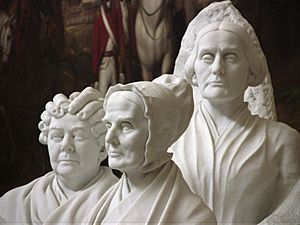
Stanton began to regain recognition for her role in the women's rights movement with the rise of the new feminist movement in the 1960s and the establishment of academic women's history programs.
- She is commemorated, along with Lucretia Mott and Susan B. Anthony, in the 1921 sculpture Portrait Monument by Adelaide Johnson in the United States Capitol. Placed for years in the crypt of the capitol building, it was moved in 1997 to a more prominent location in the U.S. Capitol rotunda.
- In 1965, the Elizabeth Cady Stanton House in Seneca Falls was declared a National Historic Landmark. It is now part of the Women's Rights National Historical Park.
- In 1973, Stanton was inducted into the National Women's Hall of Fame.
- In 1975, the Elizabeth Cady Stanton House in Tenafly, New Jersey, was declared a National Historic Landmark.
- In 2020, the Women's Rights Pioneers Monument was unveiled in Central Park in New York City on the 100th anniversary of the passage of the Nineteenth Amendment giving women the right to vote. Created by Meredith Bergmann, this sculpture depicts Stanton, Susan B. Anthony and Sojourner Truth engaged in animated discussion.
Images for kids
-
A petition to Congress for a women's suffrage amendment signed by Stanton, Anthony, Lucy Stone, Antoinette Brown Blackwell, Ernestine Rose, and other leading women's rights activists
See also
 In Spanish: Elizabeth Cady Stanton para niños
In Spanish: Elizabeth Cady Stanton para niños



